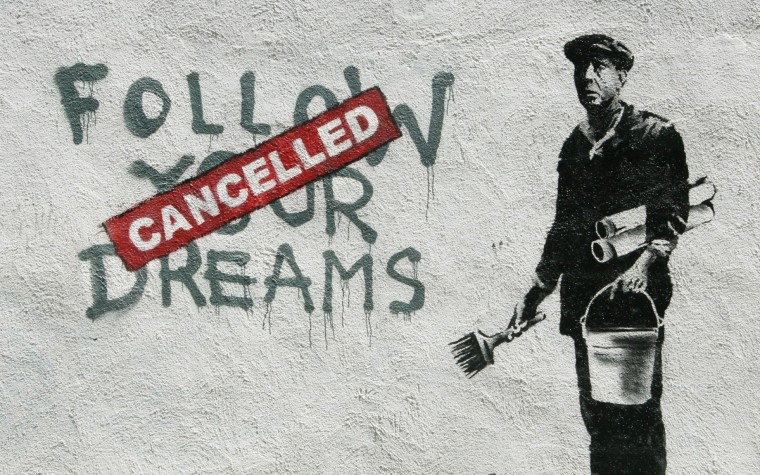Introduction
Most societies have long held a view that graffiti and street art are forms of vandalism, associated with rebellious teenagers and criminals, characterised by spray-paint defacement. On the other end of the spectrum, “fine art” traditionally includes 17th-century paintings and sculptures that are traded within elite auction halls. These two forms of art—street and traditional—have been seen as asymmetrical and even opposite, with little consideration for them belonging in the same category of “art.” In the realm of art, two seemingly disparate worlds have long coexisted – traditional “fine art” and the often-dismissed graffiti and street art. However, an enigmatic street artist has emerged on the international scene, challenging these notions and potentially placing these two art forms on equal footing. This artist, known as Banksy, has redefined street art through a fusion of humanitarian satire and thought-provoking messages that call for societal change.
Humanitarian Satire Art: Banksy’s Message of Change
Banksy’s art is marked by dark humor, controversial imagery, and unambiguous political statements. While his works often mock various aspects of society, they are open to interpretation, making them powerful tools for promoting social transformation. Through his distinct stenciled style, Banksy’s graffiti and sculptures have startled the art world, with each piece found in unexpected and secluded locations. Regardless of their placement, his artworks consistently convey provocative political messages, shedding light on pressing issues he believes deserve attention.
Son of a Migrant from Syria: A Bold Statement on Immigration
One of Banksy’s renowned murals, “Son of a Migrant from Syria,” depicts Apple founder Steve Jobs as an immigrant carrying a bundle on his back and a Macintosh Classic in hand. Positioned in the “Calais Jungle,” a migrant camp in France, this mural emphasizes the deplorable living conditions faced by immigrants. Through this artwork, Banksy highlights that successful entrepreneurs, like Steve Jobs, often have immigrant backgrounds, challenging the notion that migration is solely a burden on a country’s resources.

Love is in the Air: A Symbol of Peace Amid Conflict
In the midst of the Arab-Israeli conflict, Banksy’s controversial work “Love is in the Air” depicted a teenage protester poised to throw a bouquet of flowers. Placed near the West Bank Wall in Jerusalem, this image symbolizes a call for peace amidst a deeply rooted socio-political struggle. While some rejected the message, others saw it as a plea for mutual agreement, advocating a harmonious resolution to a fiercely divisive issue.

Slave Labour: Capitalism’s Unseen Crimes
Banksy’s piece “Slave Labour,” found on a Poundland store in London, portrays a child working on a sewing machine beneath the Union Jack. This image sheds light on illicit labor practices often associated with cheap retail prices. Despite Banksy’s own financial success, he consistently criticizes the damaging effects of modern capitalism, drawing attention to the hidden consequences of a global economy.

Protest with a Lifespan: Street Art’s Vulnerability
While Banksy’s art garners a devoted following, the transient nature of street art poses challenges, especially when pieces are removed for auction. Many of his works have been relocated, triggering public outrage and demands for their preservation. Ironically, the financial gains from such sales contradict Banksy’s anti-capitalist stance, underscoring the pervasive influence of market forces even within the art world.
The Face Behind the Mask: Anonymity as a Statement
Banksy’s international acclaim is not only attributed to his art but also to his mysterious identity. Despite various speculations, his true persona remains elusive. This anonymity underscores his focus on art’s universality and impartiality, emphasizing that anyone can be an artist, regardless of background or status. Banksy’s desire to elevate street art parallels his efforts to elevate non-traditional artists globally.
The Banksy Effect: Elevating Street Art’s Status
Banksy’s rise to fame has led to the “Banksy effect,” resulting in increased recognition and appreciation for street art. This effect signifies a shift in societal perspectives, bridging the gap between street art and traditional fine art. As his art gains value and popularity, Banksy continues to employ his characteristic satirical approach, even pranking the art world through a self-destructing artwork that ironically increased its worth.
Conclusion
Banksy’s artistic revolution has transcended boundaries, challenging preconceived notions about art and sparking dialogue on pressing societal issues. Through his distinct blend of humanitarian satire and provocative messages, he has not only elevated the status of street art but also compelled society to engage with overlooked problems. The enigmatic nature of his identity further enhances his impact, highlighting the universal nature of art. Banksy’s legacy will likely endure as his artworks continue to provoke change, bridging the divide between street art and fine art in an ever-evolving art world.

Iftikar Ahmed is a New Delhi-based art writer & researcher.





